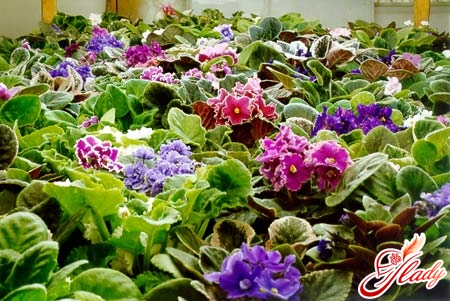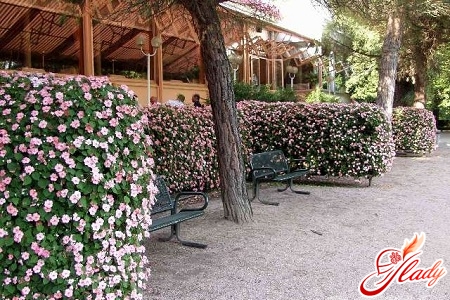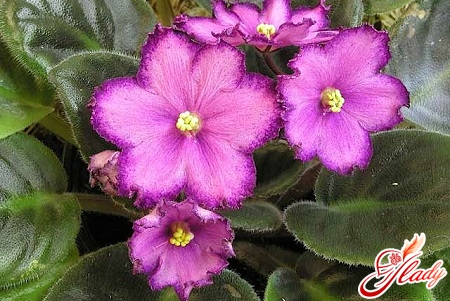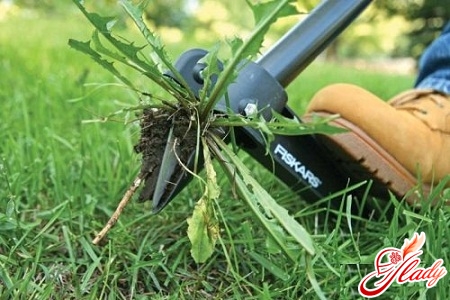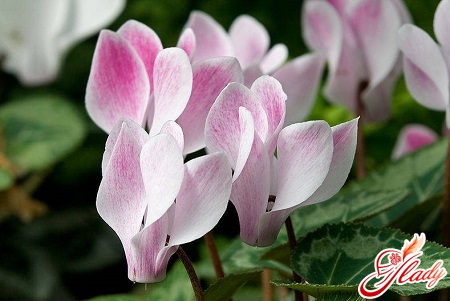 Cyclamen is considered one of the most beloved andpopular indoor plants, which is not surprising, because it amazes with its original beautiful flowers, which decorate any room! In total, two subspecies of cyclamen are common in indoor culture: European and Persian. The difference between them is that the Persian blooms in the winter, when other plants, including the European cyclamen, mostly fade.
Cyclamen is considered one of the most beloved andpopular indoor plants, which is not surprising, because it amazes with its original beautiful flowers, which decorate any room! In total, two subspecies of cyclamen are common in indoor culture: European and Persian. The difference between them is that the Persian blooms in the winter, when other plants, including the European cyclamen, mostly fade.
Cyclamen characteristic
Cyclamen is a perennial plant that formscorms. As a rule, tubers are flat-rounded with a diameter of fifteen centimeters. Cyclamen tuber has one growth point, and if it is damaged, the plant may first get sick, and eventually die. During the period of active growth, rosettes are formed on the tubers, which have rather lush leaves and peduncles with single flowers, up to twenty centimeters long. The bush of the plant can be up to thirty centimeters in height. However, among cyclamens there are also low-growing varieties, the height of which is no more than fifteen centimeters. Cyclamen leaves can be rounded and heart-shaped, they are located on petioles of a red hue. Their length is from ten to fifteen centimeters, and the color is dark green, with a peculiar silvery pattern. Today, breeders continue to develop new varieties of cyclamens, reproducing more and more colorful and bright varieties with different colors. Today we will look at how to properly grow cyclamen and care for such an exotic plant, and also identify the main problems that you may encounter during the growth of cyclamen, namely - why it sometimes turns yellow and dries. But first, let's figure out how to choose the right plant. When buying cyclamen, pay attention first of all to its leaves and tuber. The foliage should not be damaged, wilted or dry at the edges. But the tuber should not show signs of rot, it should be smooth, not wrinkled. It is best to buy cyclamen at the beginning of autumn, when the plant is actively blooming. It is desirable that the flower already has many buds when purchased.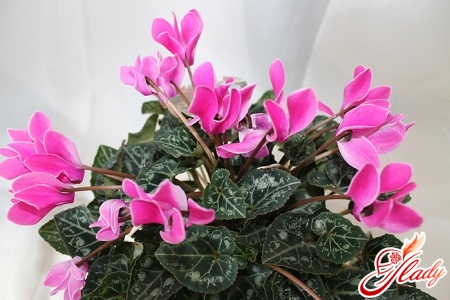
Problems in the cultivation of cyclamen
Anyone who has ever encounteredgrowing cyclamens, wondered why the plant's leaves periodically turn yellow - this problem continues to be the most difficult to solve and incomprehensible for many. It is worth saying that the cause of any problem is improper care of the plant. Therefore, it is important to know how to provide the plant with comfort in indoor conditions. If you notice that the cyclamen suddenly turned yellow, and the flowers remain healthy and strong, then the cause is most likely excessively dry warm air. This plant does not tolerate temperatures above seventeen degrees. A lack of liquid or direct sunlight can also contribute to sudden yellowing. Rotting of leaves and flower stalks, which can generally lead to the death of the cyclamen, is another problem. Here the reason is over-moistening of the soil, especially if water gets on the upper part of the tuber. In no case water the sprout part - water as carefully as possible. Sometimes cyclamens have a short flowering period, which can be caused by over-dried air, too high air temperature or poor watering. There may be many reasons for this, and it may be difficult to identify one. The most important thing is to remember to feed the plant throughout the entire growth period, as well as during flowering. And finally, leaf deformation. As a rule, this occurs due to damage by aphids or mites. As soon as you notice that pests have appeared, start washing the cyclamen, or rather its leaves, with special insecticidal soap. Alternatively, use soap intended for animals. Additionally, spray the plant with special preparations, such as Fitoverm or Agravertin - they are odorless and will not have a negative effect on the cyclamen. We will talk about how to prevent the appearance of mites later, but for now we will give some advice on caring for the cyclamen.
We care for the cyclamen correctly
Like all plants, cyclamen has its ownFeatures and nuances in the process of care. The temperature, for example, should be cool. Thirteen to fifteen degrees will be enough. Please note that the temperature should not fall below ten and rise above twenty degrees; if you do not follow the recommended temperature regime. then soon you will get a sad result: one day you will find that the cyclamen leaves have turned yellow, and the buds have wilted. There are some rules that concern lighting. The place where you placed the cyclamen should be well lit. It is good if the light is diffused and bright enough. But direct sunlight should be avoided - shade the plant a little at lunchtime, but in the evening or early in the morning direct light will benefit the plant. Considering why the leaves turn yellow, it is worth mentioning watering. We have already said before that excess or lack of moisture will immediately affect the plant. During the growing season, watering should be stable and regular - use the immersion method. And during watering, pour water closer to the edge of the pot. Try not to let liquid stagnate in the pots with the plant. Water for irrigation should settle for some time so as not to provoke the development of rot or yellowing. Those leaves and flowers that turn yellow and dry out a lot should be carefully cut off with scissors, trying not to damage the sprout area. Now about humidity. Cyclamen is a plant that prefers high humidity air. Place the pot on a tray with pebbles or wet peat - this will be ideal for cyclamen. You should not spray the plant, it is better to humidify the air around it from a spray bottle with a fine spray. Cyclamen care after flowering requires a special approach. In particular, this applies to the Persian variety. After the cyclamen has finished flowering, you need to cut the flowers down to the tuber, and also reduce watering and stop fertilizing and feeding. Dried and yellowed leaves should not be cut off, but twisted out immediately with the petioles. Closer to spring, when the remaining leaves dry out completely, the cyclamen will go into a dormant state. This is the time to stop watering. You need to turn the pot with the plant on its side and place it in a cooler place. It should stay here until mid-July. After that, the plant is moved to a shaded place, preferably in the fresh air. You need to periodically moisten the soil - it should always be moderately moist. As soon as you notice the first leaves, this will serve as a signal for replanting. Replanting cyclamen also has its own rules - during this process, the soil is completely changed. The following soil is suitable for indoor plants: part of leaf and humus soil combined with a share of turf soil and sand. During replanting, check the root system and remove all rotted, damaged and diseased roots. You do not need to buy a pot that is too large or too small for cyclamen. The most optimal diameter is thirteen to fourteen centimeters.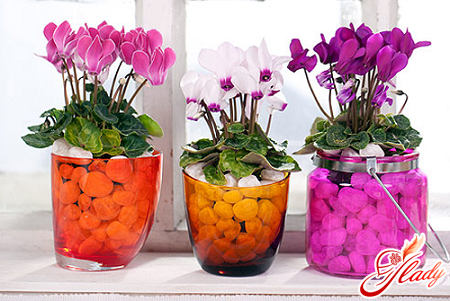
Fighting mites
Answering the question of why the leaves turn yellow andthe buds dry up, you need to remember about the plant's pests. Cyclamen is usually susceptible to the effects of mites. The fact that the mite has affected the plant is indicated by the yellowing and dryness of the leaves. If the flowers are blooming, the pest can infect them too - they will soon begin to wrinkle and wither. It is important to prevent such an infestation and recognize it in time. Buy an insecticidal aerosol in the store and dilute it with water. Place the pot with cyclamen in water and thoroughly water the plant, including the lower leaves. Spray the remaining aerosol over the plant and let the substance settle. Now take the cyclamen out of the bucket and put it in its usual place. Repeat the procedure in a couple of weeks to prevent infestation. It is better to treat the plant in the evening, after dark, because this is the time when the mite is especially active. A good preventive measure is a periodic inspection of cyclamen tubers, which also need to be cleaned and treated in cases where the mite has damaged the plant. For treatment, use the same aerosol, the substances of which will help the cyclamen easily survive the dormant period and subsequent transplantation. Cyclamen is a wonderful houseplant that will never cease to delight its owners with exquisite beauty. The rules listed above are enough to provide cyclamen with proper care and grow an impressively beautiful plant that will bring comfort and tranquility to your home.




